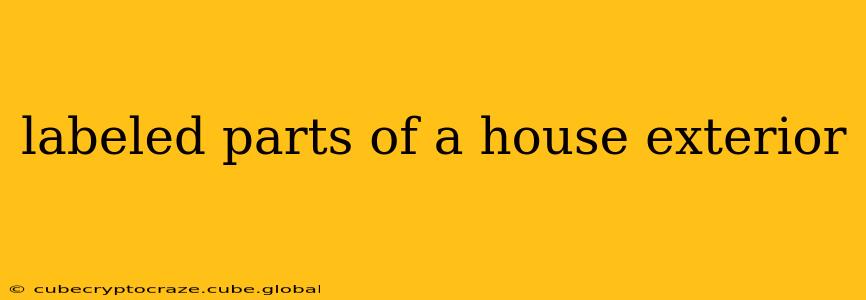Understanding the different parts of a house exterior is crucial for homeowners, prospective buyers, and anyone interested in home improvement or architecture. This guide provides a detailed overview of key exterior features, explaining their functions and common materials used. We'll cover everything from the foundation to the roof, ensuring you're well-equipped to navigate the world of home exteriors.
Foundation
The foundation is the unseen but critical base of your house. It transfers the weight of the structure to the ground, providing stability and support. Common foundation types include:
- Slab-on-grade: A concrete slab poured directly onto the ground. Simple and cost-effective but less adaptable to changes in soil conditions.
- Basement: A below-ground structure offering additional living space and often provides extra storage. More expensive to construct but adds significant value to the property.
- Crawlspace: A low-clearance space between the ground and the floor joists, allowing for access to plumbing and electrical lines. Can be prone to moisture problems if not properly ventilated.
The foundation's exterior is usually made of concrete or poured concrete blocks (CMU), often treated with waterproofing materials to protect against moisture damage.
Walls
The walls are the primary structural and aesthetic components of a house's exterior. Materials commonly used include:
- Wood-frame: The most prevalent type, consisting of a framework of lumber sheathed with plywood or oriented strand board (OSB).
- Brick: Durable, aesthetically pleasing, and fire-resistant. Requires skilled installation but offers excellent longevity.
- Stone: Provides a natural and luxurious look, offering excellent insulation and durability. A more expensive option than brick or wood.
- Concrete: Extremely durable and requires minimal maintenance, often found in contemporary or modern homes.
- Stucco: A cementitious plaster applied to a wire mesh or lath backing. Offers a textured finish and good insulation.
What are the different types of siding?
Siding is the outermost layer of the wall, providing protection from the elements and contributing significantly to the house's curb appeal. Popular siding options include:
- Vinyl: Affordable, low-maintenance, and comes in a variety of colors and styles.
- Wood: Classic, aesthetically appealing, but requires more maintenance than vinyl.
- Fiber cement: Durable, fire-resistant, and low-maintenance, offering a more sophisticated look than vinyl.
- Metal: Durable and long-lasting, often seen in modern or industrial-style homes.
Roof
The roof protects the house from the elements, diverting rainwater and snow. Key components include:
- Roofing Materials: Asphalt shingles, tile, metal, slate, and wood shakes are common choices, each with its own lifespan, cost, and aesthetic appeal.
- Rafters: The sloping wooden beams that support the roof's structure.
- Gables: Triangular portions of the wall at the end of a pitched roof.
- Ridge: The horizontal line where two roof slopes meet at the highest point.
- Eaves: The overhanging lower edge of a roof.
- Fascia: The vertical board that runs along the edge of the roof, covering the ends of the rafters.
- Soffit: The underside of the eaves, usually ventilated to allow airflow into the attic.
What are the different types of roofing materials?
Choosing the right roofing material depends on factors such as budget, climate, and architectural style. Each offers a unique combination of durability, longevity, and aesthetic appeal.
Windows and Doors
Windows and doors provide access to the house and allow for natural light and ventilation. They should be chosen for energy efficiency and security. Different materials include:
- Wood: Traditional, aesthetically pleasing, but requires regular maintenance.
- Vinyl: Durable, energy-efficient, and low-maintenance.
- Aluminum: Durable, but can be less energy-efficient than other materials.
- Fiberglass: Strong, energy-efficient, and requires minimal maintenance.
Other Exterior Features
Other important features include:
- Gutters and Downspouts: Channel rainwater away from the foundation, preventing water damage.
- Porch and Deck: Provide outdoor living spaces.
- Landscaping: Enhance the house's aesthetic appeal and provide erosion control.
- Driveway and Walkways: Provide access to the house.
This comprehensive guide provides a solid foundation for understanding the labeled parts of a house exterior. Remember to consider your specific needs, budget, and climate when making decisions about exterior materials and features. Consulting with a professional is always recommended for major home renovation or construction projects.
